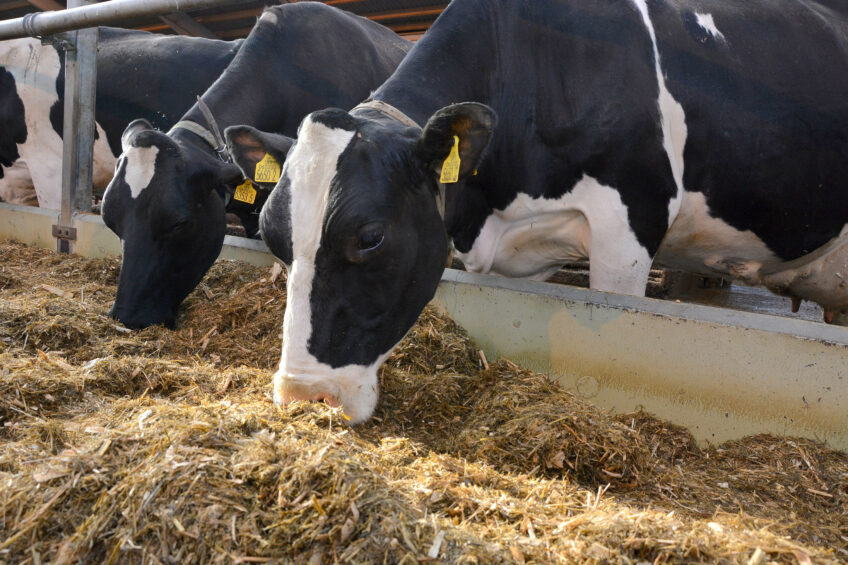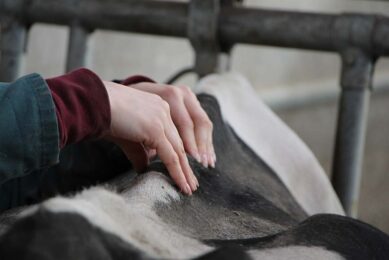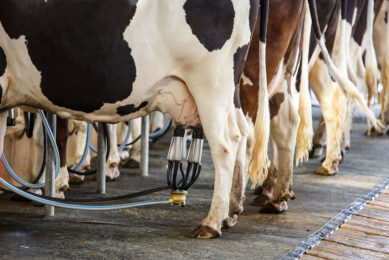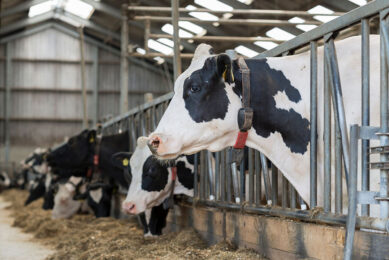College dairy updates farmers on herd performance

It’s been 5 years since Greenmount Agricultural College in Northern Ireland officially opened its new £2.5 million (€ 2.8 million) dairy unit to act as a centre of excellence for both students and dairy farmers alike.
Today the unit is home to 200 Holstein cows thanks to the addition of the CREAM herd that was kept separate at the college until recently when it was integrated into the main herd. The CREAM herd consisted of 30 high genetic merit cows managed separately by Foundation Degree and Honours Degree students on a daily basis. However, the herd concept was 25 years old and due to changes in course requirements by the awarding bodies and a problem getting students to stay at the college over weekends it was decided to end the project.
Update on latest results
Recently, the college staff held 2 open days to update dairy farmers on the herd’s latest production figures and management systems. The herd is currently averaging 8,777 litres per cow per year fed on 2,729 kg per cow per year. Cows are achieving a milk solids yield of 658kg and are producing 2,712 litres per cow from forage. All that equates to a margin over the concentrates figure of £1,863 per cow per year (€ 2,107). The milking cows are currently being fed in 3 groups to achieve good feed efficiency. The herd is split into fresh calved cows and heifers, high yielders and late lactation cows. First and second cut silage is being fed to the fresh calved and high yield cows together with a maize silage and dairy blend. Late lactation cows are being fed on second cut silage plus in parlour concentrates fed according to yield.
Grenmount’s breeding season started on November 22, 2017 and achieved a submission rate of 89% in the first 3 weeks with 65 cows inseminated. The first group of cows inseminated were pregnancy diagnosed on December 27 and January 3 with 27 of 34 cows presented positive.

Heifer rearing
Heifer rearing on any dairy farm is important as it accounts for around 20% of milk production costs. The average age for dairy heifers calving in Northern Ireland in 2016 was 27.5 months with 7% of heifers calving at 24 months old. Data from Northern Ireland milk recorded herds shows that heifers calving at 24 months have the highest lifetime yield compared to heifers calving at any other age. Also, for every one month delay in calving beyond 24 months on average a loss of 570 litres of lifetime milk is incurred per month.
Analysis of milk recording data
Milk recording data shows that heifers in Northern Ireland are calving on average at 27 months, which represents an additional rearing cost of approximately £258 compared to calving at 24 months. By improving heifer rearing practices this will also have a positive effect on the carbon footprint of your farm. Analysis of milk recording data indicates that there is a strong correlation between heifer age at first calving and lifetime yield and longevity. Heifers calving at 24 months of age produce approximately 7,000 litres more milk in their lifetime than heifers calving at 36 months of age as the earlier calving heifers spend approximately 7 months longer in the milking herd than heifers calving at the greater age.
Target weights
Rearing replacement heifers to calve at 24 months or less, at approximately 90% of mature body weight, is recognised internationally as a key target to minimise rearing costs and greenhouse gas emissions from dairy farming.
During the heifer rearing period, target weights for weaning at 2 months old is 75kg, service at 14 months at 390kg, and a post calving weight of 570kg. To achieve these weight targets requires an average growth rate of 0.75kg per day.
Replacement heifers for the 200 cow CAFRE dairy herd are bred from sires selected primarily on £PLI (Profitable Lifetime Index) and a number of individual traits including milk protein, fertility, lifespan and SCC (Somatic Cell Count). The target for the college is to have all their replacement heifers calve at 24 months.
Dry cows
Within the Greenmount herd significant emphasis is placed on body condition scoring, particularly in the 8-12 weeks before drying off. Nutrition during the dry period is another critical aspect as it can determine the level of metabolic diseases post calving i.e. milk fever. On this basis cows are divided into 2 feeding groups (close up and far off) and fed accordingly at Greenmount. In Northern Ireland, feed is the single largest cost for a dairy herds cost. For CAFRE benchmarked farms, purchased feed (concentrates) accounts for 65% of variable costs. Therefore, improved feed efficiency on farm represents an opportunity to improve herd profitability.
Within the Greenmount herd, strong emphasis is placed on conserving high quality forages for winter feeding to optimise milk from forage. Forage is fed to the cows through a diet feeder with diet composition monitored through the Keenan inTouch service.
Slurry application
The majority of cattle slurry produced by the dairy herd at Greenmount is spread on swards used for silage making using trailing shoe or band spreading techniques.
Prior to first cut, approximately 39m3/ha (3,500 gallons per acre) is spread in February or March depending on weather and ground conditions. A further 28 m3/ha (2,500 gallons per acre) is spread after each cut. Cows are grazed from mid-March to mid-November most years. In spring, the first cows grazed are the autumn calving cows with numbers grazing increased as grass growth increases. In autumn, spring calving cows are the last cows to be fully housed.
Rotational paddock grazing is practiced at Greenmount with grass covers monitored weekly. Any grass surpluses identified are quickly removed as baled silage for feeding later in the season.
Ammonia
Approximately 50% of the nitrogen in typical dairy cow slurry is in the form of ammonia. The ammonia is readily lost to the air from the surfaces of livestock buildings, from slurry storage and during slurry spreading. The slurry management systems employed at Greenmount Campus has been designed to reduce the loss of ammonia N from slurry and increase the slurry nitrogen available to grow grass. Flooring systems within the milking and dry cow sheds and the heifer rearing accommodation have been installed to Dutch designs to reduce ammonia emissions and provide good gripping surfaces for the cattle. The majority of slurry is stored in covered above ground stores to reduce ammonia loss and the accumulation of rainfall.
Join 13,000+ subscribers
Subscribe to our newsletter to stay updated about all the need-to-know content in the dairy sector, two times a week.










